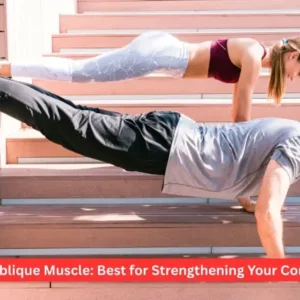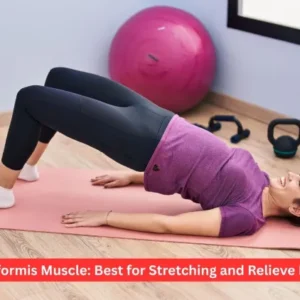Jumping jacks are one of the simplest and one of the most effective exercises using your whole body to improve your cardiovascular fitness, coordination, and your muscular endurance. Although they may seem simple, they do work several muscle groups in the body and can be an excellent warm-up, conditioning exercise, or part of a high-intensity workout. Understanding which muscles are working can help you make the most of the exercises and avoid injury by performing the exercises correctly.
- What muscles work on executing Jumping Jacks? Primary Muscles Activated
- Supporting and Stabilising Muscles
- Jumping Jack Definition and Benefits
- How to Do Jumping Jacks
- What do jumping jacks work like these muscles?
- A Jumping Jack into Your Workout
- Jumping Jacks and HIIT
- Ideal Form to Drive Muscle
- Bottom Line
- Frequently Asked Questions
What muscles work on executing Jumping Jacks? Primary Muscles Activated
The muscles responsible for performing jumping jacks mostly exercise several of these major muscle groups that work harmoniously to bring out the move.
Leg Muscles
- Quadriceps: These muscles at the front of the thigh will now also be used to extend the knee on pushing off the ground.
- Hamstrings: They are at the back of the thigh. They play an important role in bringing the leg movement back to the original position.
- Glutes: The Gluteus maximus, medius, and minimus muscles are involved in jumping. Calves – The gastrocnemius and soleus muscles counteract your heels and help with landing on a go.
Muscles of the Body
- Abdominal Muscles – The rectus abdominis and transversus abdominis are the stabilisers of your body in movement.
- Obliques – This muscle is responsible for keeping balance and control as your arms and legs go out or in.
- Lower Back – During exercise, the erector spinae tense up to maintain your posture and spinal alignment.
Upper Body Muscles
- The anterior and posterior deltoids – they congregate actively when your arms are raised overhead and your back is downward.
- This upper back muscle assists in controlling your shoulders’ movement when your arms move, the Trapezius.
- Latissimus dorsi – Assists pulling your arms to your sides.
- Pectorals – Chest muscles will make your arms move as they open and close.

Supporting and Stabilising Muscles
While these aren’t the muscles that move primarily, a few other muscles-the ones in the lower part, too, assist in doing the proper jumping jacks.
- Hip flexors: Slide the leg backwards and to the other side, have someone pull on the top of the leg.
- Forearms: Help control arm movement up and down motion.
- Intrinsic Foot Muscles: To help with balance and stability on landing.
Jumping Jack Definition and Benefits
Routine jumping jacks are dynamic, full-body plyometrics, they typically appear in numerous exercise programs. This whole body exercise not only elevates your heart rate, but it also engages numerous muscle groups with one exercise. One of the most benefit-packed aspects of jumping jacks is their versatility. Moreover, they may be done anywhere without the need for special equipment. This makes them a great addition to any fitness routine, no matter if you are in your house, gym, or travelling.
The advantages of jumping jacks are more than just a fun, full-body exercise – it can also improve muscle strength and coordination. Doing this exercise regularly can result in higher bone density, so crucial for long-term skeletal health. Jumping jacks are also good for preventing several different health issues, like high blood pressure, type 2 diabetes, and different kinds of cancer. Doing this simple yet effective exercise will help you tremendously in your total health and fitness goals.
How to Do Jumping Jacks
Jumping jacks, when done correctly, allow you to get the maximum impact of the exercise while minimising the chance of an injury. Start with your feet together, feet together, your arms hang loose at the sides of your body. This is your starting position. From this starting level, jump out over your feet so they are much wider apart than your shoulders, and swing your hands out and over your head.
Next, bring feet back together and go to the starting position, with the arms back down to the sides. This is a jump. For beginners, you start with sets of 10-20 jumping jacks, and you can increase as you get fit. More advanced athletes can do 75-100 jumping jacks on squat sets. And of course, remember selection is as important: sync the in and out movement of your legs while your in and out arm motion, and find a smooth fluid motion.
What do jumping jacks work like these muscles?
The muscles utilised in a jumping jack work together for a couple of diverse benefits:
- Improved muscular endurance: Repeating exercises bulk the muscles over time.
- Increased coordination: Upper and lower bodies must coordinate.
- Cardiovascular training: Boosts circulation, also accelerates the heartbeat.
- Increased flexibility and mobility: It aids the type of joints.
- In addition to these advantages, jumping jacks are also an excellent cardiovascular exercise, providing total body fitness, fat burning, and weight loss are benefits of comprehensive health.
Variations to target muscles differently
Many jumping jack variations target multiple muscle groups or just boost the challenge.
Modified Jumping Jacks
- Decreases the load while working the core and legs.
- Perfect for hobbyist users or to recover from an injury.
Power Grips
- Deeper squats between jumps will increase activation in the Quads and Glutes more.
- Power-creating piece to the movement.
- Squats Jacks is another higher-level variation to enhance your routine training.
Crossover jacks
- Arms and legs cross, bigger core recruitment.
- Improves coordination and mobility.
Plank jacks
- It works the core, shoulders and hips while you’re in a plank position.
- Increases core stability and endurance.

A Jumping Jack into Your Workout
Jumping jacks are versatile and a great way to add to other workouts, based on your fitness level and your goals. For a particular exercise, try 10-minute HIIT (or Tabata fashion of training) with jumping jacks. This high-intensity interval training can help you burn calories and the cardiovascular system in a short time.
You can even incorporate jumping jacks into a circuit workout and pair that with other exercises to make up a complete workout. In an attempt to increase intensity, they might want to add in resistance bands or light dumbbells to jumping jacks. This increased resistance can also help to build up your legs, shoulders and core. If you want to do an alternative version of low-impact exercise, step forward instead of jumping. Your primary muscles will still be worked, while your joints will have a reduced impact.
Jumping Jacks and HIIT
Jumping jacks are an effective high-intensity interval training (HIIT) workout, and here are several good reasons. They raise the level and therefore get you even more calories burned quickly. These vitamins make them perfect for people looking to efficiently hit their health and fitness goals.
One of the great advantages of zippers is their versatility. They can be quickly modified to suit every fitness level to ensure everyone from the beginner to the more experienced athlete can participate. And, plus, jumping jacks are no-equipment required, which means you can perform them anywhere – in the gym or at home. Adding jumping jacks to your HIIT workout will definitely up your aerobic endurance and fitness level, helping you to reach your fitness and health goals sooner.
Ideal Form to Drive Muscle
To make sure all your muscles are working correctly without taking an injury, keep proper form:
- Start with your feet together: Bend a bit at the knees to relieve the impact.
- Engage your core: Keep a neutral spine for your lower back.
- Land softly: Stay away from high impact besides your knees and ankles.
- Keep your movements under control: Keep from over–swinging your arms or over– extending your legs.

Bottom Line
Jumping jacks work out several muscle groups in your body, so they are an excellent workout for building endurance, strength and coordination. Once you know the muscles engaged, you could apply good type and adaptations to ignite the strongest possible outcome. Whether you do them as a warm-up, as a full-on HIIT routine, or as pure, stand-alone exercise, the jumping jacks are a simple but powerful way to give your overall fitness a boost.
Frequently Asked Questions
1. What muscles do jumping jacks primarily work?
Jumping jacks are a workout that exercises many muscle groups, among which are the quadriceps, hamstrings, glutes, calf muscles, deltoids, trapezius, latissimus dorsi, pectorals, abdominals, obliques and lower back muscles. These muscles come together to give you the force, stability and coordination you need to work the exercise.
2. Are jumping jacks good for weight loss and cardiovascular health?
Yes, jumping jacks are a strenuous, whole body workout during which your heart rate can beat fast, burn calories and strengthen cardiovascular endurance. They can be great for fat loosening as well as weight loss when run consistently as part of a normal fitness routine.
3. Can beginners do jumping jacks, and how many should they start with?
Absolutely. Beginners can begin with 10 to 20 jumping jacks per round, and increase repetitions as the body begins to get stronger. Additionally, modified versions are available for those who are looking for a low-impact version.
4. What are some variations of jumping jacks to target different muscles?
Some alternative methods include Squat Jacks for a more intense leg movement, Crossover Jacks for the core and coordination and Plank Jacks for the core and shoulder workout and Modified Jacks for less stress while still working the core and legs.








2 thoughts on “Great Jumping Jacks: What Muscles are Used In It”
Reading this feels like breathing in a calm, expansive space. The text offers room for thought and emotion to circulate, producing reflection and subtle clarity.
Thank you — I’m glad the words gave you that sense of calm and space.